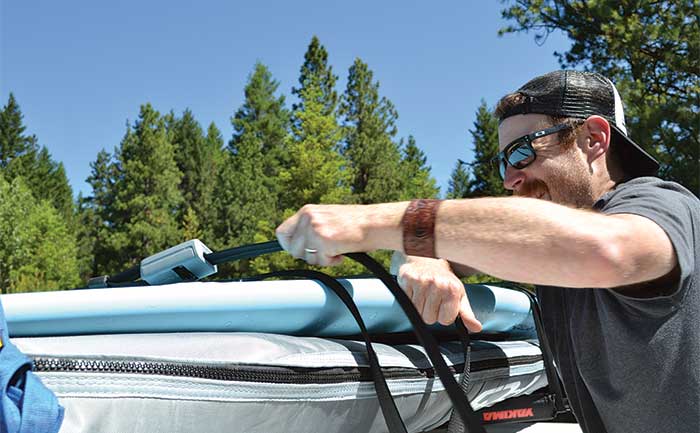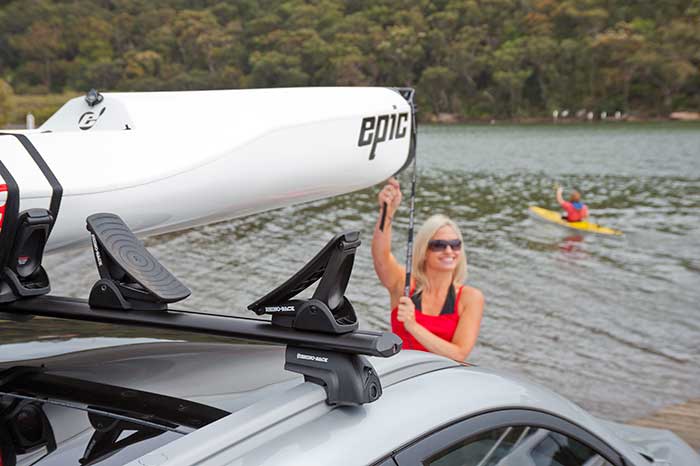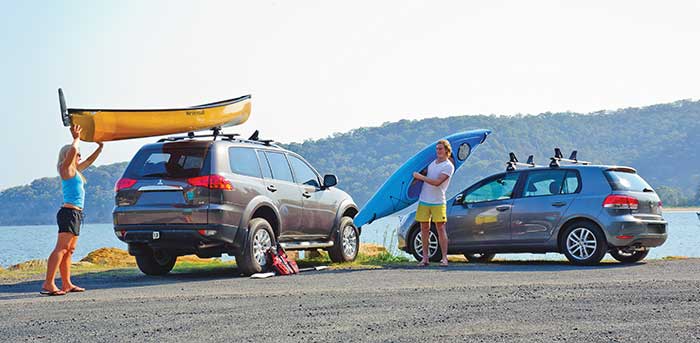Advertisement
Tips on transporting your favorite kayak or stand-up paddleboard on the roof.

Transport your standup paddleboard flat, with the fins up. Remember because of its shape the board acts like a wing when the wind rises up under it, which can put a heavy strain on your rack.
If you haven't caught the smallcraft bug, chances are you've at least thought about adding a kayak or stand-up paddleboard (SUP) to your fleet. They are a great activity to pursue once you've reached a quiet cove, or to extend your range into skinny water for fishing. Or maybe you just want to add them to the list of toys you take along with your boat on your annual road trip to a far-off body of water. But at a typical length of 12 or more feet, and with limited secure storage space inside many trailered boats, the safest place to transport your paddle craft may be aboard your tow vehicle.
Tip
A good roof rack can free up storage space in your boat, while keeping your craft secure and out of the way. Once you're on the water, all those creative ways of transporting your craft aboard your boat are fine, but on the highway a canoe, SUP, or kayak can act as a sail in crosswinds or like a wing if air gets underneath it. Each has a large amount of surface area and can negatively affect the handling of your trailer. At highway speeds, you're subjecting your kayak or SUP to hurricane-force winds — not a good time to be lax in how you secure it. Of course, the same is true when you place it on your tow vehicle, so a properly installed roof rack and good tie-downs are a must.
Rack 'Em Up
There are three basic types of car-top carriers. The easiest is the factory roof rack installed on your vehicle. It should come with side rails and cross bars. If your vehicle didn't come with a set of cross bars, you can either go back to the dealer and pay a boutique price or find a compatible aftermarket solution. The cross bars, adequately spaced, are essential for weight distribution. Aftermarket racks are also available through your local paddle sport dealer or outdoor store. The foundation of these add-on rack systems are called the "feet," which sit firmly on your rooftop and attach to the roof's edge along the gutter.

Put a twist in the strap (below where it touches the board or kayak), and you won't have any vibration in the wind.
A cross bar will attach to the feet. In total, you will have four feet and two cross bars, usually sold as a kit. Aftermarket racks have the advantage of being easily removable, and most brands offer attachments that will also work with other equipment like your bike, skis, cargo carrier, and even lumber. It might be worthwhile to buy a rack that locks to your vehicle; some racks can cost as much as the cargo they carry and are easily stolen.
The third and most economical option is the soft rack. These racks are usually just a tubular pad or contoured foam blocks that will protect your roof and your equipment. An inflatable version exists, too. For soft racks, a length of webbing goes through the padded material and through your open doors. You'll then shut the door after you have passed the webbing through the interior of your car. We recommend this only for short hops, and not at highway speeds.
Rack It Up!
SUP paddles should never be included in your board bag. Over-tightening straps can damage them and your board.
Avoid loading your kayak or canoe with excess gear. Many roof racks have a 90- to 200-pound limit. Don't test it.
Beware of an overhanging or higher-than-usual load. Many innocent fast food drive-thrus and garage doors bear the scars.
Load straps have a tendency to vibrate at high speed. Put a few twists in your strap to eliminate wind noise.
If possible, remove your racks to improve gas mileage when they aren't in use.
When in doubt about proper loading, visit your local outdoor store. Many will help you properly install your new rack at no charge.
Stack 'Em Up
Your cross bars should be padded, and your local outdoor retailer probably will carry durable rip-resistant pads, usually with their store name or a brand emblazoned on it. Pool noodles or pipe insulation work, too, as an alternative, but won't hold up in the sun over the long run. To keep your SUP ding-free, purchase a board bag with carrying handle to make your life easier. The next consideration when loading your craft is its orientation on the rooftop. Kayaks are usually placed right side up, canoes upside down, and paddleboards upside down with the fin at the front. However you choose to load your SUP, always consider wind deflection and avoid over-tightening straps that will harm your craft.
If carrying more than one SUP, windsurfer, or surfboard, place them side by side if your roof racks are wide enough. You can also stack them, but orient them in the same direction. Place padding between each to avoid dinging surfaces. Carrying more than one kayak can be accomplished with racks that tip them on their sides. Canoe and kayak racks often have additional features, including rollers to assist with loading and unloading. Generally, two should be your limit whatever you're hauling.

Tie 'Em Up
The final touch is a set of quality webbing straps that have a toothed cam mechanism to prevent your load from loosening. Load straps come in varying lengths so be sure they're long enough to go over your craft, underneath the bar on the opposite side, and back. Look for straps that have padded ratchets and hooks that won't scratch paint. It's also a great idea to have a line from the front and rear of your craft to the end of your vehicle. A simple rope will do the trick. For paddleboards, purchase a device that will create tiedown points on an SUP. It is also smart to use a cable lock or set of load straps with an integral locking mechanism to prevent theft.
